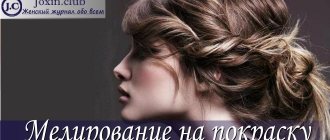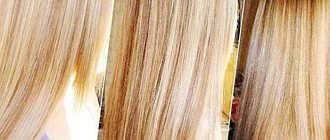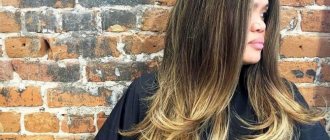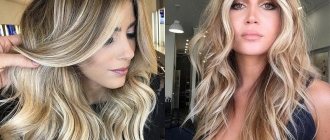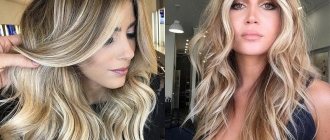What kind of hair treatment is this?
Superficial highlighting is the coloring of only the top part of the hair on the head. The method is very popular among women, since the bulk of the curls remain a natural shade, while the strands dyed along the top highlight it favorably.
Highlighting of the upper zone of the hairstyle can be done in any shades, both close to the natural tone and in contrasting colors.
High-quality colorists believe that
surface lightening is suitable for straight hair of any length, with an even haircut .
In this case, strands of a different color hidden inside the hair will in any case become invisible. The weightless mesh in the surface gives the haircut volume and liveliness, the strands can be chosen - wide or thin, placed often or rarely along the hair. Partial highlighting is also acceptable, affecting only the bangs or the temporal part. The color palette is chosen freely; both natural range and unusual, spectacular colorful colors are appropriate.
An interesting type of surface highlighting is bleaching strands of regular width that differ from the main tone by 2-3 values. The result is incredibly gentle, the haircut looks spectacular and voluminous.
It is not recommended to use surface lightening on haircuts in a cascade or in steps. The varied lengths of the strands show individual layers; if they are not toned, the curls will look thin.
Options for medium hair
Medium-length dark hair can be dyed in different ways. It all depends on the shape of the haircut, the texture and shade of the strands, as well as the personal tastes of the client. Among the most popular highlighting techniques:
- American. The classic technique involves lightening rare or frequent strands by 4-5 levels, followed by tinting with soft ammonia-free paint. Depending on the natural color type, the strands are given a warm golden or cool silver-ashy hue.
- Red. A very popular technique that is easy to do at home. For work, several single-phase paints are used in wine, reddish-brown or copper tones. Fans of extravagant options can try shades of cyclamen or fuchsia. Highlighting can be frequent or rare, it all depends on the shape of the haircut.
- Colored. A bold idea that effectively emphasizes natural dark strands. For work, several harmonizing or contrasting shades are used. To make highlighting bright and effective, the strands are pre-lightened and then a toning agent is applied to them. You can also use quickly washable paints that are applied without lightening, directly from the tube.
- Venetian. A variation of California highlighting designed specifically for brunettes. The hair is dyed with an indentation from the roots, which allows you to repeat the procedure no more often than after 2 months. Rich wine, bluish-violet, chestnut, red or amber tones are used, creating beautiful shimmers.
- Salt and pepper. Original technology suitable for brave girls.
The strands are lightened by 5-6 levels and tinted with silver-platinum or light ash ammonia-free dye.Dark and light curls alternate, creating a memorable image.
- Veiled. A complex technique for real masters. It requires very careful separation of the strands, which are lightened and tinted in layers. As a result, the effect of a light veil is created on the hair, from under which the curls of the main color are visible. This highlighting creates a volume effect and is suitable for owners of thin and not too thick hair.
- Partial. The technique involves highlighting individual sections of hair. Most often, wide or narrow strands are located on the bangs, but it is also possible to dye the bulk of the hair, and a single strand is left on the bangs. The technique requires high skill and artistic taste so that the bleached strands correctly highlight the features of the face and haircut line.
Advantages and disadvantages
Advantages:
- coloring is suitable for representatives of the fair sex of different ages;
- convenient for accenting short and medium haircuts, for long curls;
- dyeing locks of hair on foil is gentle on the curls, you can preserve the natural color and update the look;
- hides gray hair;
- Frequent staining is not required.
Flaws:
- cannot be done if you have previously had a perm;
- allergic reactions;
- the process is labor-intensive and lengthy;
- A salon procedure for long hair will be expensive.
Varieties
There are many professional zonal highlighting schemes. And some of them are completely unrelated to the traditional division of hair into zones: temporal, parietal, occipital, etc. After all, we are talking about incomplete staining, which is also called rare.
Accordingly, the brightening composition can be applied as follows:
- Only on the top strands - looks great on graduated haircuts, making them even more voluminous and textured.
- Only on the lower strands - an original highlighting effect is created, most expressive on dark hair.
- Highlighting on the face - brightens and refreshes the image, visually removes several years of age, and ensures a smooth “flowing down” of the main color.
- Feather dyeing looks bold and daring on short and medium layered haircuts.
- Highlighting the ends - looks great on long hair, straight or wavy, and can create the effect of natural fading in the sun.
- Clear zones - only bangs, hair on the temples, etc. are highlighted.
- Highlighting the top of the head (with or without bangs) looks great when it creates contrasts to the base color.
- Radical darkening - it is often used by natural blondes who do not want to change the color too radically.
- Superficial highlighting is a very rare lightening of strands only in the upper layer of hair from the crown of the head along the entire length.
This number of styles allows you to choose the optimal coloring option for curls of any type and structure.
How to choose the right shade?
The range of colors used for surface highlighting is extensive and suits many women. The recommended shades by color type are as follows.
For fair-haired ladies:
- pearl;
- ashen;
- mocha;
- blond;
- Ivory.
If your hair is light brown, then you can safely experiment with all shades of wheat and golden.
For girls with dark brown hair:
- light honey;
- lactic;
- Ivory;
- natural blonde.
Suitable for women with black curls:
- bronze;
- gold;
- milk chocolate;
- creamy chocolate;
- milk coffee;
- coral;
- caramel.
For lovers of an extraordinary image, you can use:
- eggplant;
- plum;
- emerald;
- ashen;
- crimson;
- blue;
- soft blue.
Photo
Next in the photo you can see the result of highlighting the strands on top of the head.
Is it possible to carry out the procedure for strands yourself at home?
Dry, unwashed curls are dyed, which are first combed well with a brush.
Dark curls are pre-lightened with blonding powder mixed with an oxidizing agent, concentration 6% - 9%. Light and brown strands are highlighted without bleaching - with single-phase dyes. The coloring algorithm is as follows:
- Prepare paint according to instructions.
- Cut the foil into wide strips.
- Select the strands on one side of the parting, place them on foil, color them, and wrap them.
- Let the dye sit for the required amount of time. Remove the foil and wash off the paint.
- Rinse hair with shampoo for colored hair and apply conditioner.
How long will it last?
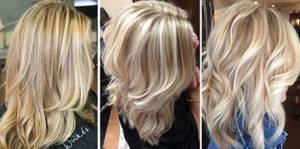
- wash your hair using toning shampoos;
- make therapeutic or skin care masks once a week;
- Apply balms after each wash.
Hair care
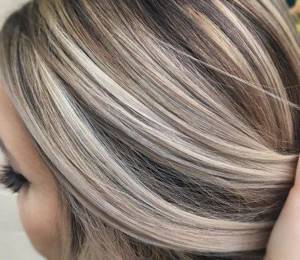
- Use special shampoos and conditioners designed for highlighted hair.
- Try to use tools and styling products as little as possible.
- Do not use too hot water to wash your hair.
- In the summer, under the scorching rays of the sun, hide your curls under a hat.
- Do not comb strands when wet or damp.
Who should not do it and why?
There are certain restrictions for any highlighting:
- weakened, unhealthy hair, especially after illness;
- curls that were affected by perm;
- recently dyed curls;
- when dyeing with henna, basma, and so on, the desired result will not be achieved.
Surface highlighting is a great way to make your image bright , catchy, attractive and updated. This method of dyeing strands is well suited for doing it yourself.
Types of hair highlighting
The beauty industry is one of the fastest growing industries today. Hundreds of world-famous stylists create new cosmetic products and techniques for various procedures every day. It is because of this that the highlighting procedure also has several varieties. It is worth noting that highlighting, regardless of its type, is a complex coloring technique.
Types of highlighting:
Balayage
Balayage . This technique is one of the most popular in the world. Its essence lies in the fact that the strands are painted with light up-down brush movements, without a specific pattern or pattern. Often, a lightening dye is used, less often a dark or bright one. What is noteworthy is that while the pigment is applied to the hair, it remains in the open air and is not wrapped in foil. This ensures a smooth transition from the client’s native (primary) hair color to the dyed strands. The peculiarity of this method of highlighting is that the master can give free rein to his imagination, and the client receives an exclusive result, despite the prevalence of the method.
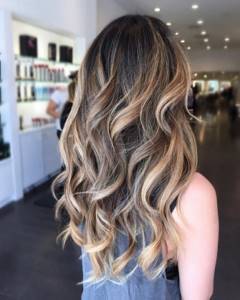
Shatush
Shatush . This method can be called a subtype of balayage, since the coloring techniques are similar. A distinctive feature of shatush is the preliminary creation of backcombing on the strands to be dyed. This creates the effect of a “burnt out” color. It is worth noting that the shatush technique is quite difficult to perform.
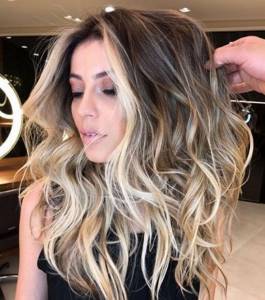
Babylights
Babylights. A type of highlighting in which a large number of strands of hair are lightened. The effect of a “childish” hairstyle is created. Looking at children's hair, it immediately becomes clear what the essence of this dyeing technique is. After the Babylights highlighting procedure, the hair looks shiny, shimmering and as if a little sun-bleached - just like in childhood.

Tortoiseshell highlighting
Tortoiseshell highlighting. One of the most extravagant types of coloring. Tortoiseshell coloring combines 2 highlighting techniques - balayage and babylights. In this case, the strands that are close to the face are dyed using the balayage technique, and babylights – all the rest. It is noteworthy that during the procedure using this method, 4-5 tones of paint of the same color are used - from light to dark. It is this feature that creates the illusion of the color of a turtle shell.
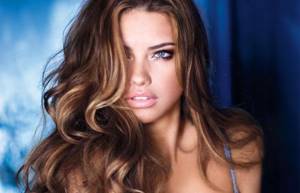
Booking
Bronding. This highlighting technique is created for brunettes who want to refresh their look and make their hair color deeper and more expressive. The essence of the method is to lighten (not to blonde!) a small number of strands. A visual effect of highlights on the hair is created. Bronding is an excellent option for girls who do not want to radically change their image, but just add a little something new to it.
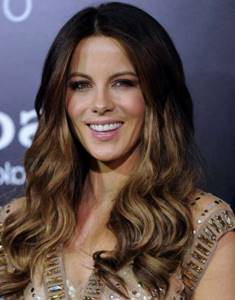
Ombre
Ombre. The essence of this type of highlighting is to lighten the ends of the hair with a smooth transition from the natural color. Ombre is also considered one of the most popular coloring methods, but also one of the most difficult. It is worth noting that after lightening the ends, they can be tinted in any color. A distinctive feature of the classic ombre is that the colored strands are much lighter than the curls in the root zone.

Degrade
Degrade. This technique is very similar to a gradient. As a result of this coloring, there are 3-4 shades of the same color along the length of the hair. The classic degradation is performed from top to bottom, from the darkest tone to the lightest. This type of highlighting looks most impressive on hair whose length is below the shoulder blades.

Dip - give it
Dip - give it. This type of highlighting is preferred by girls who love experiments and want to attract attention. Its essence is to dye the ends of the hair in bright colors. This does not result in a smooth transition. It seems as if individual strands of hair were simply dipped in bright dye. During one painting, several bright colors of paint can be used, compatible with each other and contrasting.
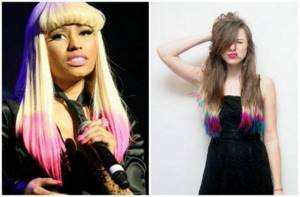
Splash - lights
Splash-lights. A technique that involves the effect of spots or splashes of dye on the hair. As with ombre, horizontal lightening of hair strands is performed with a smooth transition. However, this technique does not involve dyeing the ends of the hair, but approximately the middle of the strands. After lightening sections of the strands, you can tint the hair along the entire length to achieve a highlight effect.
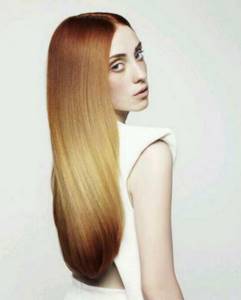
Crownlights
Crownlights. This highlighting technique is a subtype of splash-lights. The difference lies in the location of the “spray”. In this case, the root zone of the hair is dyed. A distinctive feature of crownlights is that in this case the roots of the hair turn out to be much darker/brighter than the main length.
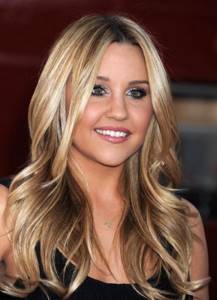
Rones
Rones. One of the newest highlighting techniques. Originally created for brown-haired women. During highlighting, the strands of a brown-haired woman are painted in red or red shades. A glare effect is created. Rones looks quite natural and adds some mystery to the images of brown-haired women.
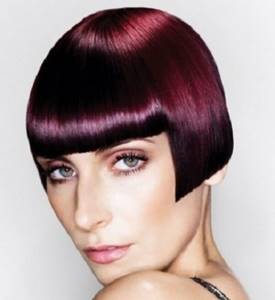
Classic highlighting
Classic highlighting. This technique has been used for many years and has not lost its popularity. Classic highlighting involves uniform lightening of thin strands along the entire length. It is also possible to tint dyed strands in the desired shades - light, dark, bright.
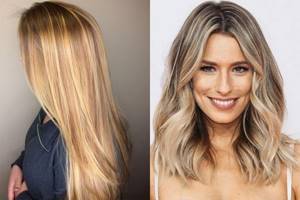
In addition to the 12 types of highlighting described, beauty salon masters can offer clients other, less popular ones, which are rather subtypes of these types.
Many have heard about highlighting, but not everyone knows that there are a large number of options for applying and placing the coloring composition, various nuances regarding the length of the strands and the selection of color shades. Let's look at the main types of highlighting.
Many have heard about highlighting, but not everyone knows that there are a large number of options for applying and placing the coloring composition, various nuances regarding the length of the strands and the selection of color shades. Let's look at the main types of highlighting.
- Classic or traditional - the lightening agent is applied to evenly distributed strands along their entire length.
- Partial or zonal - individual areas of the hairstyle (bangs, temples, top layer of hair) are dyed. This type of highlighting also includes: avant-garde - dyeing only the upper or only the lower hair in bright contrasting colors;
- basal – correction of regrown roots is carried out;
- diagonal - in a certain area of the hairstyle when dyeing, partings to highlight strands are made at an angle;
- asymmetrical – uneven distribution of contrasting accents throughout the hairstyle.

